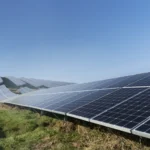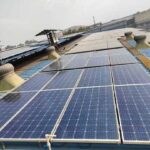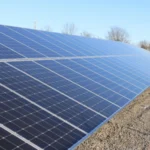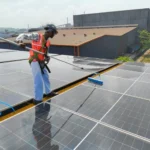Researchers Develop Technique to Improve Durability of Perovskite Solar Cells
Researchers Develop Technique to Improve Durability of Perovskite Solar Cells
A team of international researchers has developed a new technique that could significantly enhance the durability of perovskite solar cells, a promising emerging technology in photovoltaics. The technique, described in a recent study published in Science, could be an essential step towards commercializing perovskite solar cells and reducing their cost.
Perovskite solar cells are different from traditional solar cells as they are made from nano-sized crystals rather than high-purity silicon wafers. The perovskite crystals are dispersed into a liquid and spin-coated onto a surface using low-cost and well-established techniques. These types of solar cells have the potential to overcome the inherent efficiency limitations of silicon solar cells.
One key vulnerability point is the interface between the perovskite layer and the adjacent layers, called the carrier transport layer. These adjacent layers extract the electrons or holes flowing through the circuit. In cases where the chemical bonding between these layers and the perovskite layer gets damaged by light or heat, the electrons or holes can’t get into the circuit, which lowers the cell’s overall efficiency.
To address this issue, the international research team used computer simulations based on density functional theory (DFT) to predict what kind of molecules would best create a bridge between the perovskite layer and the charge transport layers. The simulations predicted that Lewis acids containing phosphorus would have the best effect.
In the lab, the team tried out various formulations of phosphorus-containing molecules and discovered that the best performance came from a material known as 1,3 bis (diphenylphosphino)propane, or DPPP. The team built inverted perovskite solar cells that contained DPPP and some without it. The team found that, with DPPP, the overall power conversion efficiency of the cell stayed high for approximately 3,500 hours under ambient conditions, without additional heating. This represents a considerable improvement compared to previous records, where perovskite solar cells tend to see a significant drop in their efficiency after 1,500 to 2,000 hours.
The team has applied for a patent for the DPPP technique and has received interest from commercial solar cell manufacturers. The researchers believe that their approach represents a new path forward, where DFT simulations and rational design can point the way towards promising solutions.
In recent months, other researchers have also made strides in perovskite solar cell research. Researchers at the École Polytechnique fédérale de Lausanne and Sungkyunkwan University in South Korea identified the cause behind the degradation of perovskite solar cells and developed a technique to improve their stability. Meanwhile, researchers at the Helmholtz-Zentrum Berlin achieved efficiencies of well above 24% for perovskite solar cells that are resistant to drop under rapid temperature fluctuations between -60 and +80 degrees Celsius over one hundred cycles.
The progress being made in perovskite solar cell research is exciting and shows promising potential for this technology to play a significant role in meeting our energy needs in the future. With continued development and investment, perovskite solar cells could become a cost-effective and efficient solution for renewable energy generation.
Suggested Articles

Generation Based Incentive Proposed for Rooftop Solar in Haryana
Haryana plans to offer Generation Based Incentive (GBI) for rooftop solar installations, promoting clean energy adoption and reducing electricity costs for consumers.

The Rise of Clean Energy: Solar Energy Trends in 2023
The solar energy industry is on the rise, as the demand for clean and renewable energy sources continues to increase. 2023 is shaping up to be a big year for the solar energy sector, as new technologies and innovations are expected to drive growth and expand the reach of solar energy.

How to Calculate Savings from Rooftop Solar Solutions: A Complete Guide
Calculating savings from rooftop solar solutions is essential for planning your investment. This guide explains how to estimate cost reduction, return on investment, and long-term financial benefits for residential, commercial, and industrial solar projects.

Solar String Sizing Check: Did Your Installer Get It Right?
Worried your rooftop solar strings might be sized incorrectly? Check these tips to ensure your Solar PV system is installed for maximum efficiency and safety

How Total Solar PV Power Affects Solar System Efficiency
Total solar PV power represents the combined power output of a solar photovoltaic system. This guide explains its meaning, calculation, and how it directly impacts solar performance, efficiency, and long-term energy generation.

Are Colleges and Schools ready to take up Solar challenge?
Adopting solar energy can help schools and colleges reduce electricity costs and promote sustainability. This guide explores how educational institutions can implement rooftop solar projects, the benefits, and what steps are needed to take on the solar challenge effectively.

Monitoring Services for Solar Plants by Smart Roof Solar to Maximize Performance and Efficiency
Smart Roof Solar provides advanced monitoring services for solar plants to ensure maximum performance and efficiency. With real-time data tracking and intelligent analytics, our monitoring solutions help detect issues early, reduce downtime, and enhance the overall energy yield of your solar system.

1 MW Solar Power Plant Cost in Madhya Pradesh | A Complete Industrial Solar Guide
A detailed guide on the cost of setting up a 1 MW solar power plant in Madhya Pradesh. Learn about pricing, EPC components, land requirements, subsidies, and expected payback for commercial and industrial users.